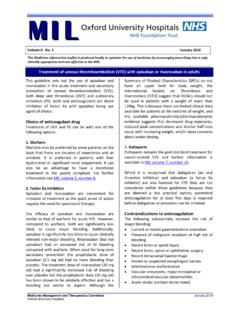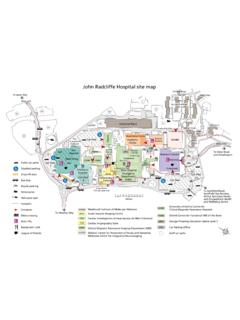Transcription of Spindle Cell Sarcoma - ou h
1 Oxford University Hospitals NHS Trust Spindle Cell Sarcoma Information for patients What is Spindle cell Sarcoma ? Spindle cell Sarcoma is a rare malignant (cancerous) tumour which can develop in the bone or soft tissue. It can arise in any part of the body but is most common in the limbs (arms and legs). There is no definite known cause for this type of tumour, but it can sometimes occur as a result of previous radiotherapy treatment. Spindle cell Sarcoma can affect any age group, but is most common in people over the age of 40. It affects slightly more men than women.
2 Diagnosis We will confirm your diagnosis once we have carried out X-rays, ultrasound and MRI scans (imaging) and have the histology (results) from the biopsy taken from the tumour. The Spindle cell Sarcoma will also be graded', depending on how fast it is growing and how likely it is to spread to other parts of the body. As with all cancers, Spindle cell Sarcoma can spread (metastasise). to other parts of the body. We will check for this very quickly after your diagnosis by taking CT or PET CT scans. Spindle cell Sarcoma can spread to the lungs, so we will closely monitor your chest with X-rays at each clinic appointment during your follow-up.
3 We may also take further CT scans if we feel these are needed. Treatment options The usual treatment for Spindle cell Sarcoma is surgery to remove the tumour. Chemotherapy can be used in certain situations and we will discuss this with you we feel this is a suitable option. We will decide on the best treatment for you depending on a number of factors. These include: the position, size and grade of the tumour whether it has spread to other parts of the body your general health and wellbeing. Follow-up Once the tumour has been removed, you will remain under the care of the Sarcoma team for your follow-up.
4 This will include clinic appointments at the following times: every 3 months from your surgery, until 2 years after your surgery every 6 months between years 2-5 after your surgery once a year between years 5-10 after your surgery. Further information Macmillan: Softtissuesarcomas/Aboutsofttissuesarcom as/Typesofsofttissuesarcoma. aspx Sarcoma UK: What is Sarcoma ? Cancer Research: bone-cancer/about/types-of-bone-cancer#s pindle Bone Cancer Research Trust If you have a specific requirement, need an interpreter, a document in Easy Read, another language, large print, Braille or audio version, please call 01865 221 473.
5 Or email Author: Helen Stradling, Advanced Nurse Practitioner August 2015. Review: August 2018. Oxford University Hospitals NHS Trust Oxford OX3 9DU. OMI 12244P.

















